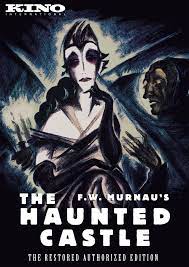
Lord von Vogelschrey (Arnold Korff) and his wife Lady von Vogelschrey (Lulu Kyser-Korff) are entertaining friends that have come to castle Vogelod for some hunting. Unfortunately, so far there has been nothing but rain in the forecast. Suddenly an uninvited guest appears at the castle. Count Johann Oetsch (Lothar Mehnert) presents himself to Lord Vogelschrey. Rumors surround the Count. Many whisper that he killed his brother Peter Oetsch (Paul Hartmann) in order to gain the family fortune. Nothing was definitely proven but years later the rumors still persist and Oetsch has basically been ostracized from society.
Lady Vogelschrey is very upset that the Count is there. She is expecting Baron Safferstatt (Paul Bildt) and his wife Baroness Safferstatt (Olga Tschechowa). The Baroness was Peter Oetsch’s wife and Johann’s sister-in-law at the time Peter was murdered. Since the death of her husband the Baroness remarried. Lord Vogelschrey asks Johann to leave but he refuses.
When the Baron and Baroness arrive, Lady Vogelschrey breaks the news to the Baroness that Johann is there. At first the Baroness insists that she must leave but Lady Vogelschrey tells her that Father Faramund (Victor Blutner) is expected. Since the Baroness is anxious to talk to Faramund she and the Baron decide to stay. The remainder of the day the Baron and the Baroness appear depressed. The mood at the castle is somber.
The next day Father Faramund arrives. The Baroness tells the priest that he is the only one she can talk to about her feelings and the circumstances that are causing her depression. She tells him about her relationship with her husband and how he changed after he went away on a trip. He became a religious zealot and ignored everything else in his life. The marriage deteriorated. Then she met Baron Safferstatt. Her husband and his brother had fights about Peter wanting to give away all his money to the poor. Soon after all this happened Peter was shot. Unable to go much further the Baroness tells Father Faramund that she will continue her confession the next day.
The next day Father Faramund disappears. Now new suspicions arise. There are accusations that Johann is responsible. Some believe the priest is dead. But there is more going on and some deep dark secrets will be exposed.
“The Haunted Castle” AKA “Schloss Vogelod: Die Enthullung eines Geheimnisses” AKA “Castle Vogeloed” was released in 1921 and was directed by F. W. Murnau. It is one of Murnau’s earliest surviving works and is a German silent mystery drama. The film has been wonderfully restored. There is both a German intertitle version and an English intertitle version. It is based on the 1921 story “Vogelod Castle” by Rudolph Stratz.
The film contains flashbacks and a couple dream sequences. One of them is reminiscent of Murnau’s later work “Nosferatu” 1922. Other than the dream that one character experiences, the title is a bit of a misnomer. The only haunting is in the minds of the principals. In reality it is quite the melodrama. There are secrets and a murder but these are things that happened in the past and are coming to light now and everyone must face reality.
Some are disappointed that it is not a true horror story but Murnau did do quite a few dramas as well as horror so you get what you get in this instance. I do agree that Olga Tschechowa’s acting as the chest heaving overwrought widow was overdone.
What you can’t see here alone is how Murnau’s art developed early in his career. The only other early film of his that is not lost, at this point in time, is “Journey Into The Night” 1921 which is also a drama.
Even as a drama the film is a bit slow and although it was fairly interesting it doesn’t have that wonderful German Expressionistic flair that some of Murnau's other works do. Despite not being on par with “Nosferatu” or “Faust” 1926 it was still a nice little mystery. I’m glad we have it to enjoy.

